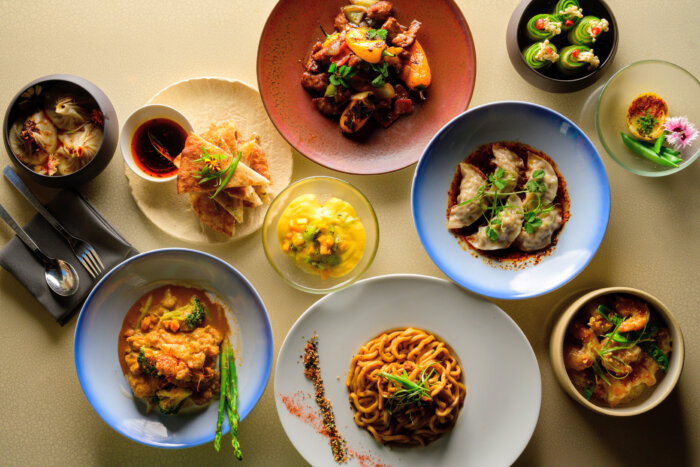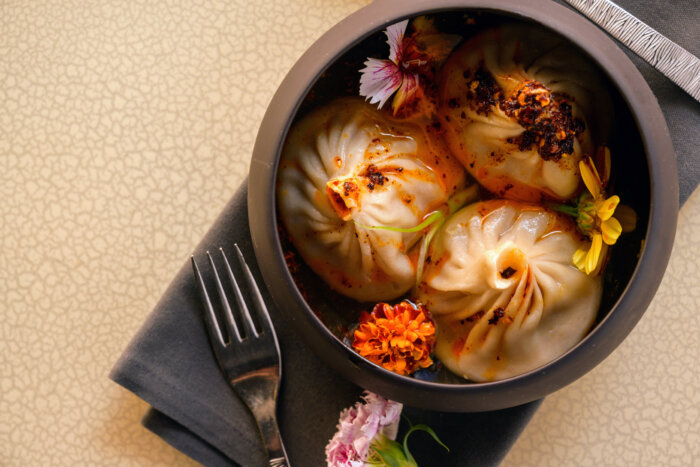The first tastes derived from dining with Volver’s new Chef-in-Residence — Dim Sum Garden executive chef and co-owner Sally Song — is the rare subtlety in her spiciest sauces (ginger chili and garlic oil for her signature dumplings) and savory curries, along with the flavorful tenderness of her Honey Walnut Shrimp and Black Pepper Steak.
Much of the inspiration for what Song designs for her menus comes from her mother, Chef Shizhou Da and her recipes for Xiao Long Bao and traditional homemade Shanghai-style dim sum.
Song will be sharing her Shanghainese cuisine at Volver through June 3.

You’re at Volver to represent yourself and Dim Sum Garden. How does your Volver menu serve tradition and confound expectations?
My Volver menu reflects my personality, life, and goals by showcasing the flavors and cooking skills that I have learned throughout my culinary journey. As owner of Dim Sum Garden, I’m passionate about introducing Shanghainese cuisine to a wider audience and demonstrating the unique flavors and ingredients that make it so special. While my menu at Volver includes dishes inspired by traditional Shanghainese cuisine — Pork Soup dumplings and Scallion Pancakes, for example — I have added my own twist to these dishes by incorporating Asian special ingredients and experimenting with new flavors and textures. For example, the chicken curry and black pepper steak are specially created for the Chef-in-Residence event. I do believe that my Volver menu will confound expectations by challenging diners to think differently about Shanghainese cuisine. Some will come with preconceived notions about what to expect. My dishes, however will surprise and delight them with unexpected combinations and creative presentations.
Your mother, Shizhou Da, a fifth-generation chef and expert in traditional Shanghainese cuisine, inspired your cooking skills and entrepreneurial vision in the heart of Chinatown. How do you believe that you have interpreted all that your mother gave you while finding your own path?
As a chef, I believe it’s important to respect and honor the traditions that have been passed down through generations of chefs, while finding ways to uniquely stamp dishes you create. In my case, my mother taught me foundational techniques and flavors of traditional Shanghainese cuisine. From there, I experiment with new ingredients, flavors, and presentations.

What was your first-ever favorite dish to cook and why?
Pork with sauce noodles. I love making noodles because it requires skill and creativity, and I find it to be a fun, rewarding process. Additionally, this particular dish is one of my favorites because it’s both delicious and versatile, and it’s always a hit with diners at our restaurant. In Chinese culture, noodles are a symbol of happiness and longevity, so I love incorporating them into special occasions and festivals. Cooking pork with sauce noodles is a way to bring joy and celebration to the people who enjoy my food.
What should diners know about Shanghainese flavors?
This cuisine is characterized by a balance of sweet and savory flavors, with a slight emphasis on sweetness. The use of sugar and soy sauce is common in Shanghainese dishes — they create a rich umami flavor. Vinegar is also key in many Shanghainese dishes, adding a sour note that balances the sweetness. For example, in this event menu, traditional Shanghainese dishes include Pork Soup Dumplings (Xiaolongbao) and Pork with sauced noodles feature rich, savory broths and tender meats.
What does it mean to be a chef at this time, amidst reports of bigotry toward Asian-Americans?
I’m proud to contribute to the diverse culinary scene and share the flavors and techniques of Shanghainese and Chinese cuisine. However, I’m also aware of the challenges and prejudices faced by the Asian-American community and feel a responsibility to promote understanding and respect for all cultures. Being a chef is both a privilege and a responsibility, and I am committed to using my skills to positively contribute to the community.

How do you know Garces? What is your vibe about him and the Chef-in-Residence program?
I’ve known Garces for 15 years now, meeting first when he visited our restaurant and tried our handmade Pork Soup dumplings, which he loved. He often returned to our restaurant with his family, and we eventually became friends. We also became business partners, as I made frozen Pork Soup dumplings for his casino restaurants. My vibe about Garces is positive. I appreciate his love for good food and his willingness to collaborate. And I’m excited to be part of the Chef-in-Residence program at Volver, where I’ll use higher-end ingredients, refine my cooking techniques, and create new dishes featuring local and seasonal ingredients.
Tell us about the beef dish and the walnut shrimp.
I added several fusion dishes to the menu – Curry Chicken, Honey Walnut Shrimp, Black Pepper Steak. They are Chinese-American cuisines, adapted to suit American tastes and differ from traditional Chinese cuisine in their use of stronger spices and seasonings. The Honey Walnut Shrimp is so unique because it typically consists of crispy shrimp that has been coated in a sweet, creamy sauce and served with candied walnuts. The combination of sweet and savory flavors is not commonly found in traditional Chinese cuisine, and the use of walnuts as a key ingredient is also unusual.
And the mango tapioca pudding? Please discuss its origins and your twists.
Mango tapioca pudding is a dessert that originated in Southeast Asia, countries like Southern China, Thailand, Malaysia, and the Philippines. It is a popular dessert that is typically made with cooked tapioca pearls, coconut milk, and fresh mango. The mango tapioca pudding that I made consists of four distinct layers providing varying flavors and textures – fresh mango chunks for a sweet and fruity base. The second layer is tapioca pearls, which are soft and chewy and provide a subtle flavor that compliments the mango. The third and main layer is a coconut mango cream, which provides a creamy and rich texture with a tropical flavor. This layer is likely made up of coconut milk, mango puree, and other ingredients to create a smooth and luscious cream. Finally, the top layer is another layer of fresh mango, which provides a burst of fresh fruit flavor and also adds a nice visual element to the dessert.
What do you call what you do, and all that this menu signifies?
I think of myself as a food porter and creator. By bringing traditional Shanghainese cuisine to Philadelphia, I aim to share the amazing and delicious flavors of my hometown with a wider audience. At the same time, I also enjoy creating fusion dishes that add more variety and excitement to my menu. Something that only comes through in my cooking is my perfectionistic nature. I’m constantly striving to create the perfect dish, experimenting…until I feel like I’ve achieved my desired result. This trait can be frustrating, but it’s also what drives me to create dishes that are truly special and unique.






























